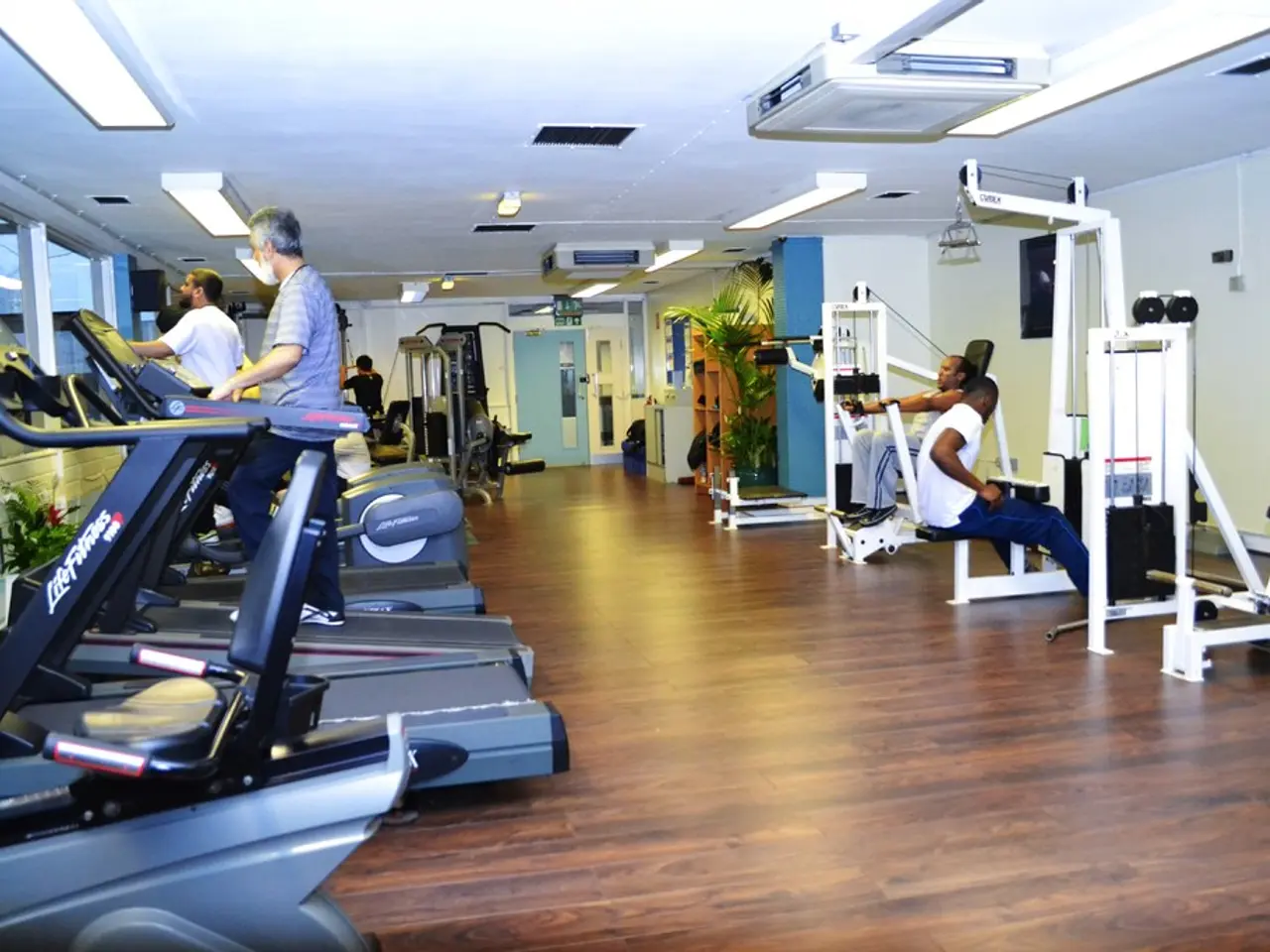Exercises Beneficial for Hypothyroidism: The Advantage of Regular Physical Activity
==========================================================
Managing hypothyroidism, a condition where the thyroid gland does not produce enough thyroid hormones, can be challenging. However, regular physical activity can offer significant benefits for those affected.
Hypothyroidism symptoms, such as fatigue, weight gain, depression, and joint pain, can make exercise seem daunting. But, moderate physical activity can boost a person's mental health, improve sleep quality, and alleviate these symptoms [1][2][3].
For individuals with hypothyroidism, the best exercise options include weekly strength training, regular aerobic exercise, yoga, and daily low-intensity activities such as walking. These exercises help improve muscle mass, metabolism, flexibility, stress levels, and overall energy, making hypothyroidism management easier [1][2][3].
Strength training, performed 1-3 times per week, builds muscle mass, which improves metabolism and bone health without requiring intense bodybuilding levels. Starting with moderate added weights, such as 5-10 pounds, is beneficial [1][2][4].
Aerobic exercise, like brisk walking, cycling, swimming, or light jogging, should be done 3-4 times per week. These activities elevate the heart rate to 50-70% of maximum for 20-30 minutes, supporting cardiovascular health and metabolism [2].
Yoga, practiced weekly, enhances flexibility, reduces stress, improves breathing, and helps regulate cortisol, all important for managing hypothyroidism-related symptoms [1][3].
Daily low-intensity activity, such as walking or light chores, helps sustain overall energy levels and metabolism [1][3].
To make exercise more manageable in daily routines, hypothyroid patients should choose enjoyable exercises, incorporate adequate rest and recovery, start gradually, spread activity throughout the day, and use frameworks like Dr. Shannon’s “REPS” (Repetition, Effort, Progression, Sustainability) [4].
The British Thyroid Foundation (BTF) suggests individuals with hypothyroidism can try walking for 30 minutes a day when introducing exercise into their routine. It is important to speak with a healthcare professional before starting a new exercise regime to ensure safety and overall health [5].
The BTF also recommends starting exercise with small, manageable goals, tracking progress, enlisting a friend or family member, choosing enjoyable exercises, incorporating multiple short sessions, practicing proper rest and recovery, and eating a balanced, nutritious diet [5].
Walking at a brisk pace can be a good form of exercise for people with hypothyroidism. Dynamic stretching can improve mobility and flexibility, which could worsen with hypothyroidism. Yoga has the potential to reduce physical pain, improve mental health, and help a person lose weight if necessary [1][2][3].
A study suggests that 60 minutes of aerobic activity three times a week for 16 weeks can improve physical and mental health, as well as alleviate symptoms, in individuals with subclinical hypothyroidism [3]. Resistance training, such as yoga and Pilates, can help manage weight, improve joint flexibility, and strengthen bones [2].
Remember, every individual is unique, and it's essential to consult a healthcare professional before implementing a new exercise regime. With the right approach, exercise can significantly improve the quality of life for those with hypothyroidism.
References:
[1] Mayo Clinic. (2021). Hypothyroidism. [online] Available at: https://www.mayoclinic.org/diseases-conditions/hypothyroidism/symptoms-causes/syc-20373463
[2] British Thyroid Foundation. (2021). Exercise and thyroid disease. [online] Available at: https://www.btf-thyroid.org/information/treatment-and-management/living-with-thyroid-disease/exercise-and-thyroid-disease/
[3] American Thyroid Association. (2020). Hypothyroidism. [online] Available at: https://www.thyroid.org/patients/patient-resource-center/things-to-know-about-thyroid-disease/hypothyroidism/
[4] Shannon, K. (2020). The REPS Effect. [online] Available at: https://www.kathrynshannon.com/the-reps-effect
[5] British Thyroid Foundation. (2021). Exercise and Thyroid Eye Disease. [online] Available at: https://www.btf-thyroid.org/information/treatment-and-management/living-with-thyroid-disease/exercise-and-thyroid-eye-disease/
- Establishing a regular exercise routine, centered on physical activity, can be beneficial for managing hypothyroidism.
- Healthcare professionals advocate for moderate exercise to boost mental health, improve sleep quality, and alleviate hypothyroidism symptoms.
- Weekly strength training, involving moderate weights, helps build muscle mass, improve metabolism, and bone health.
- Aerobic exercises like brisk walking, cycling, or swimming elevate heart rate and support cardiovascular health and metabolism.
- Yoga, practiced weekly, can enhance flexibility, reduce stress, and improve breathing for hypothyroid patients.
- Daily low-intensity activities, such as walking or light chores, help maintain energy levels and metabolism.
- To make exercise more manageable, individuals should choose enjoyable activities, employ rest and recovery, start gradually, and use the 'REPS' framework.
- The British Thyroid Foundation (BTF) recommends walking for 30 minutes a day, especially when starting a new exercise regimen.
- Small, manageable goals, alongside progressive tracking, are key for hypothyroid patients beginning exercise.
- Enlisting a friend or family member, choosing enjoyable exercises, and prioritizing a balanced diet are also essential considerations.
- Dynamic stretching, before exercises, can improve mobility and flexibility for those with hypothyroidism.
- Yoga and Pilates can help manage weight, improve joint flexibility, and strengthen bones in individuals with hypothyroidism.
- Consulting healthcare professionals before implementing a new exercise regimen is essential to ensure overall safety and health.
- With the right approach, exercise can significantly improve the quality of life for hypothyroid individuals.
- Scientific research shows that aerobic activity for 16 weeks can improve mental and physical health, alleviating hypothyroidism symptoms in subclinical cases.
- Physical activity, such as walking, can be a good exercise option for people with hypothyroidism.
- Proper nutrition and sustainable exercise practices are crucial components for comprehensive hypothyroidism treatment.
- Apart from it, regular medical check-ups are needed to establish and manage any chronic diseases or medical conditions.
- Type 2 diabetes, chronic kidney disease, respiratory conditions, digestive health issues, eye health, and hearing concerns are common chronic diseases and medical conditions.
- Cancer, various respiratory conditions, and digestive health issues can be prevented or managed through a healthy lifestyle, exercise, and proper medical care.
- Psoriasis, an autoimmune disorder, requires medical therapies and treatments to alleviate skin conditions.
- Mental health, skin care, and overall wellness are vital aspects to maintain a balanced health and lifestyle.
- Fitness and exercise, work-place wellness programs, and healthy cooking can contribute to maintaining ideal cardiovascular health.
- Women's health, including aspects like fertility, weight management, and menopause, requires personalized attention and care.
- Nutrition, skin care, and weight management are crucial factors in maintaining a healthy lifestyle, improving overall health, and managing chronic diseases.
- Physical activity, in conjunction with proper nutrition, helps maintain healthy weight and supports weight management.
- The interior design of the home, cleaning habits, and cooking practices can significantly impact overall health, wellness, and lifestyle.
- A balanced diet rich in whole foods, reduced processed items, and appropriate portion sizes fosters a healthier lifestyle and wellness.
- Lifestyle factors, such as outdoor living, sustainable living, and eco-conscious choices, can promote overall health and well-being.
- Adventure travel, cultural travel, and budget travel can provide opportunities for self-discovery, relaxation, and healthy experiences, all contributing to a balanced, fulfilling lifestyle.






